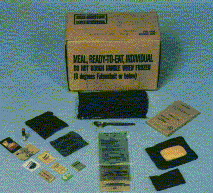
PART 1: THE MRE

One of the myths about Airborne units is that because they move by air their equipment is "light" and supposedly less capable than sea/land-locked foes and that supplies are low so Paratroopers cannot cannot fight long without resupply. The truth is that ALL U.S. Army units deploy with 3 days of combat supplies. ALL units can be resupplied by on-call airdrop indefinately. The limiting factor is volume not weight. De-cluttering the Paratrooper yields more volume.
The truth is that the Paratrooper carries the same M16A2 rifle or M4 5.56mm carbine as the "leg" Soldier or marine; uses the same wheeled vehicles (HMMWVS, 5-ton trucks, etc.); can be transported by them and M113A3 Gavin APCs, and wears the same rucksack.
The only difference is light M551 Sheridan Tanks (future M8 Buford
Armored Gun Systems) and M113A3 Gavin Armored Personnel Carriers need to be used instead of 70-ton M1A2 heavy main battle tanks and 33-ton Bradley fighting vehicles. A marine dependant on helicopter resupply from a ship 25 miles offshore "over-the-horizon" is just as logistically isolated as the Paratrooper--in fact more so if he is not taught to be resourceful and self-reliant via "live-off-the-land' Survival, Evasion, Resistance, Escape (SERE) skills. The British Royal Marines experience in the Falklands War in 1982 shows that relying on helicopters for ammo, food and water even if there are many "killer bees"; small ones available is a recipe for doing without. Frozen and starving without food, the Brits drank from mud puddles without purifying their water and got sick. The British Paras were more prepared carrying more supplies and fared better thanks to their Airborne institutional mindset of independence on non-linear battlefields behind enemy lines not co-dependence upon supply lines on linear battlefields. Here is an excerpt from Captain Wheen:
"Non availability of helo assets prohibited resupply for 5 days. As you can imagine, we were fairly hungry when it eventually came: 2 days' rations don't stretch that far."
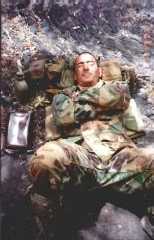
An entire case--12 MREs--can be compressed into four meal bags--food for an entire week--by removing the case, cardboard covers on every food packet, the Tabasco sauce bottle and unwanted accessory pack items (I don't drink coffee).
1st Tactical Studies Group (Airborne) Director, Mike Sparks learned as a young marine officer undergoing infantry training that he could get by with less clutter in his rucksack by compressing the MREs ("ration stripping") he as an officer had to buy @$7 each. He could always carry in his rucksack a month's supply of compressed MREs no problem IF he wanted to use them for food. More on the poor quality of MREs later. In 1994-95 time frame he wrote to Natick Labs about decluttering the MRE after he saw MRE wrappers strewn all over the National Training Center (NTC) at Fort Irwin as M113 Gavin OPFOR. Likewise, Quantico marine base is covered with MRE wrappers just a few inches under the top soil. Here is the typical Natick rejecto-gram where they cannot seem to fathom the way MREs end up being used and made into trash despite the best "disciplined" troopers trying to police up all the loose wrappers. There are simply too many loose items in the MRE cluttering the proceedings up.
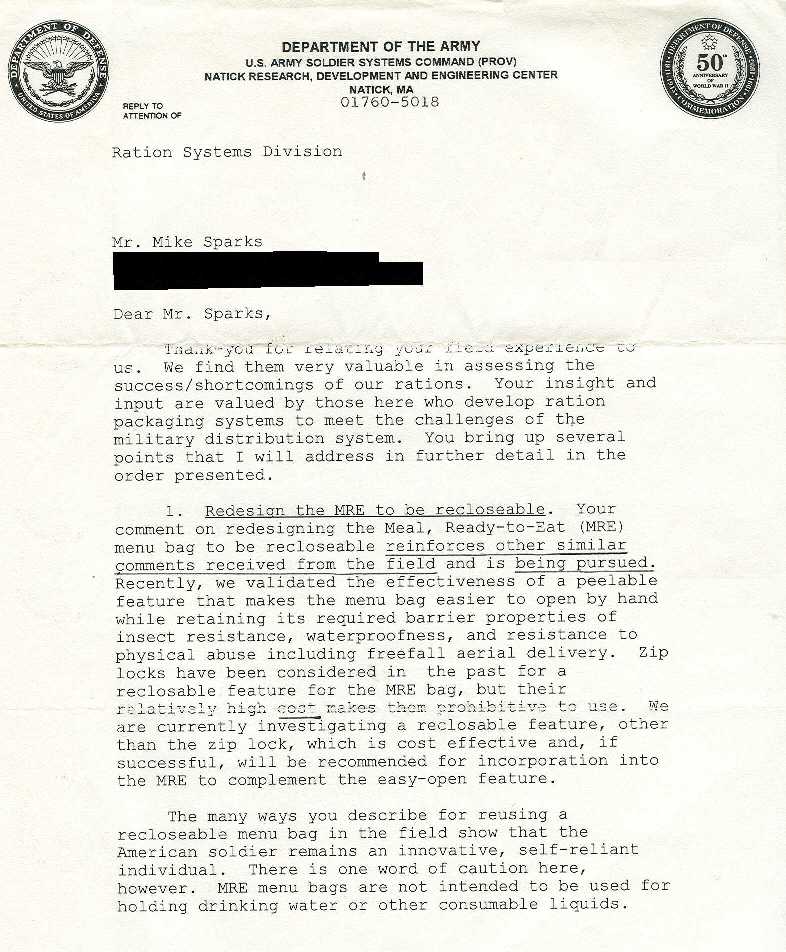
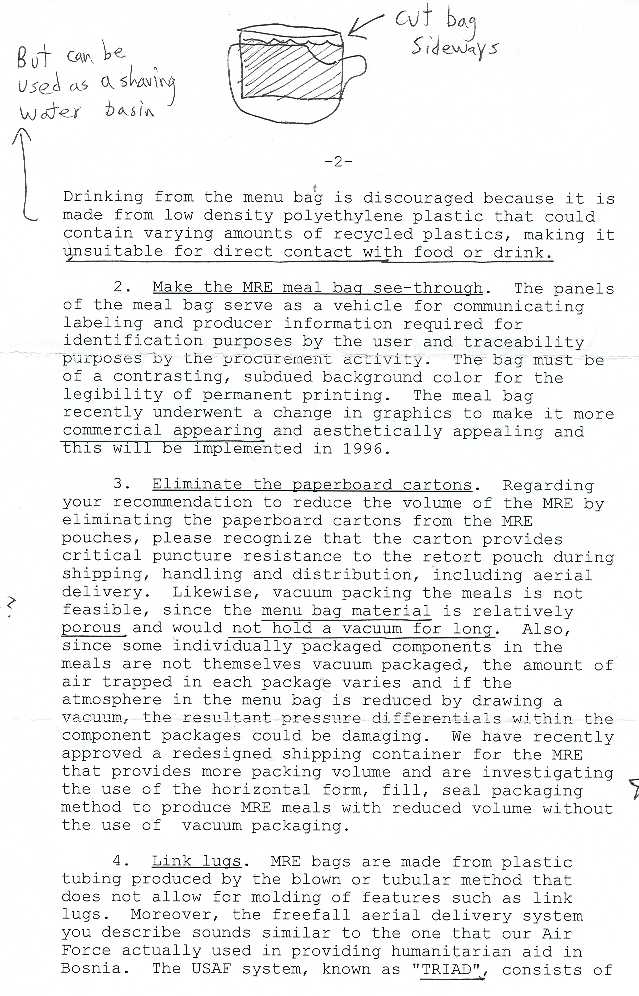
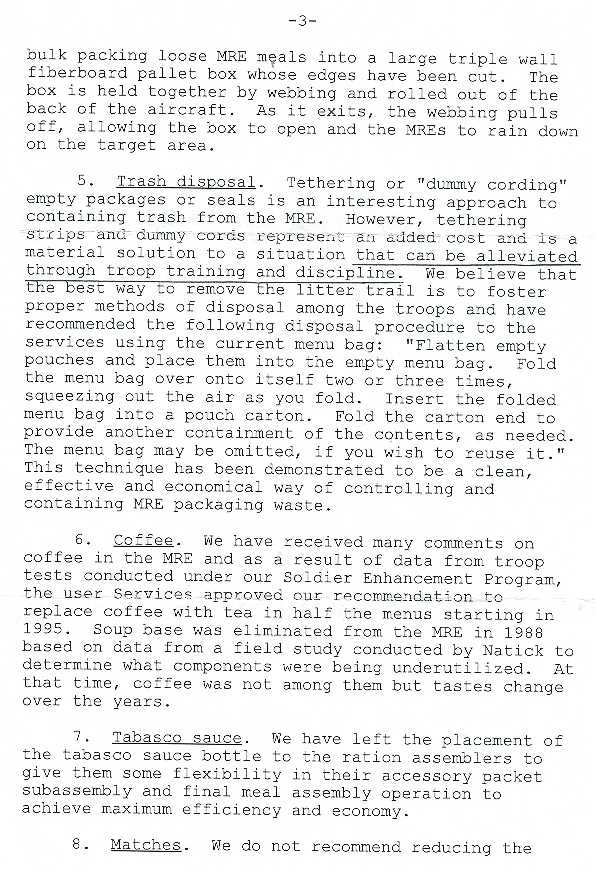
Clearly, before you leave base you should throw out half the crap Natick puts into the MRE.
In the photo below, 1SG Rudy Romero who co-wrote an article in SOF magazine on the Afghan gear debacle with LT Sparks shows how to "ration strip":
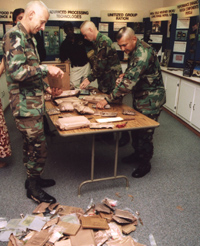
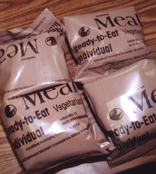
1st Sgt. Stephen Carnahan, Sgt. 1st Class Charles Nye and 1st Sgt. Rudy Romero show how they fieldstrip Meals, Ready-to-Eat at Combat Feeding's ration display room during a visit of the Soldier Systems Center Sept. 5, 2002. The Soldiers, with 1st Battalion, 187th Infantry from Fort Campbell, Ky., fought in Operation Anaconda in Afghanistan and shared their insights on Soldier items with the work force. (from U.S. Army Natick Warrior magazine)
Keep however, the MRE cases themelves for use as field fortification or vehicle hardening buy filling them in with dirt/sand/ice etc. MRE cases were used during the Cold War to hide dirt taken out of a secret tunnel under the Berlin wall to get spies into communist countries. You can fill up a MRE case faster than a sandbag and unlike the latter, the cases can be stacked and interlocked like bricks for wall construction without need of revetments. Coat them with "Rhino Snot" to make them water-proof. MRE cases filled with dirt were used by Combat Engineers to ward off RPGs from their M113 Gavins on the way to Baghdad for Operation Iraqi Freedom in 2003.
Place a rubber band over the meal bags to reclose them since Natick will not mold a zip-lock even though millions of products in U.S. stores have this feature. One meal bag (a three-day supply of food) can fit in the buttpack along with a lightweight sleeping bag (NSN 8405-01-H77-9567) and poncho-tent in a stuff sack to give Paratroopers full shelter, food and water for three days on the fighting load.
Another week's worth of supplies are inside the rucksack (existence load). Every squad could carry a water purifier so any water source--even mud puddles--can be turned into drinking water.
If dehydrated Long Range Patrol (LRP) rations NSN 8970-00-926-9222 are used instead of MREs the amount of food doubles since they're half the weight. A Paratrooper could have a month's worth of food in his rucksack, without ill effect on his foot mobility.
Every little bit counts: tear open your MREs SIDEWAYS so you an eat every morsel of food and minimize waste which attracts insects/enemy trackers. Sparks learned this trick at NTC from some clever light mech-infantry veterans...also keeps your fingers cleaner! Above is the FAX he sent to Carol Doring of Natick making the suggestion again. "If you first don't succeed..." Compressed packing and efficient eating gets you the most from your meals. If a micro-hygiene capability was built into the MRE, the Paratrooper could forgo having to carry shaving cream, soap, shampoos, razors, toothpaste paid for out of his own pocket into the field.
We see the Airborne short if we say it can only fight for three days without resupply when in actuality it can jump into battle with more than the 30 days of supplies which the Navy/marine corps brags about for it Soldiers who are less resilient than the Paratrooper.
Quality is the key on the modern battlefield. A force that can achieve surprise from the AIR (100% of the earth is covered by it) and is able to fight in any direction without depending on vulnerable resupply lines by self-sufficiency (Like Sherman's Army during the Civil War) is the force that will prevail.
Details of the latest MRE menu selections:
Close-up of some MRE food items
UPDATE 2003: Natick Labs discover troops strip-down MREs!
www.defenselink.mil/news/Dec2003/n12192003_200312193.html
Natick to Field New Combat Ration for Troops on the Move
(EXCERPT) By Donna Miles American Forces Press Service
WASHINGTON, Dec. 19, 2003--"Ration stripping," they call it when forward- deployed combat troops jettison all but the most essential items from their Meals, Ready to Eat so they don't have so much to carry as they set out on a mission.
Troops in Operation Anaconda in Afghanistan reported sacrificing all but a few carefully chosen food items from their MRE pouches to lighten their pockets and rucksacks.
These reports alarmed food technologists at the U.S. Army Soldier Systems Center at Natick, Mass, who recognized that warfighters weren't simply tossing aside "luxury" items like flameless heaters and Tabasco sauce.
Janice Rosado from the Defense Department's combat feeding program said troops were also leaving half of their food behind, losing half the nutrition and calories packed into their MREs at a time when their bodies needed them most.
In response, Rosado said Natick is developing the "first-strike ration" specifically for short-term use by warfighters during the first days of conflict.
First-strike rations are lighter and more compact than standard MREs. A single pouch holds a full day's food supply and weighs about 21/2 pounds. By comparison, three MREs weigh in at about 2 pounds heavier, Rosado said.
In addition to increasing troops' mobility, the new rations are designed to enhance their physical performance and mental acuity. They contain food easily eaten on the go, she said: a pocket sandwich, beef jerky, nuts, dried cranberries, applesauce and bread or crackers with a cheese spread. Extra energy comes packed into a fudge bar, a high-carbohydrate "HooAH" bar, an enriched beverage mix, and caffeine-laced chewing gum.
"They're a combat-driven ration that has more carbohydrates, less packaging and no luxury items," Rosado said. "They're based on what warfighters say they most frequently take with them when they're on the go."
Rosado stressed that the new rations aren't intended for noncombat operations or field training exercises.
They're "not nutritionally complete," she said, and don't meet all the dietary standards required of MREs. In addition, first-strike rations have fewer calories than MREs 2,900 to 3,000 in a one-day pouch, compared to 3,600 to 3,900 calories in three MREs.
But Rosado insists that the new rations are a big improvement over the "Band- Aid approach" she said troops have historically used to feeding themselves while on the run.
The new rations have been field tested by Army special operations troops and Navy SEALs, Rosado said, with both groups giving them the thumbs-up.
In fact, the latest prototype of the new ration proved so popular during testing that the U.S. Army Special Operations Support Command requested as many of the rations that Natick's food engineering lab could make to ship to Rangers deployed to Iraq.
Current plans call for the first-strike rations to be fielded by 2007.
2005: QUESTIONS ABOUT MRES REMAIN: DO THEY HAVE A CONSTIPATION AGENT IN THEM OR NOT? WHY DO THEY TASTE SO ATROCIOUS?
DoD policy is that MRES ARE NOT TO BE CONSUMED FOR MORE THAN 14 CONSECUTIVE DAYS.
Why?
The only logical conclusion is that they have constipation agents in them that the Army does not want to admit to. The sad truth is that in COMBAT as author/researcher retired LTC Dave Grossman documents in his new book, ON COMBAT Some people URINATE AND DEFECATE IN THEIR PANTS due to extreme fear. So by "binding Soldier's bowels up" with MREs they are not likely or even able to crap their pants. This is fine except after the combat you have to eat to live and Sparks has seen many of his Soldiers get very ill after eating MREs for 3 weeks at the Joint Readiness Training Center (JRTC) at Fort Polk, Louisiana.
Fortunately, when 1st TSG (A) Director Mike Sparks was at JRTC, one of his enterprising Soldiers decided to not eat the constipation-causing MREs and bought absolutely delicious Mountain Home dehydrated camping food. All you need to do is pour a little bit of water and you have something that was not only pleasing it filled you up.
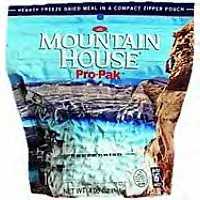 www.mountainhouse.com/about.cfm
www.mountainhouse.com/about.cfm
Here is a detailed microsoft excel spreadsheet of all the CIVILIAN MountainHouse foods available:
www.combatreform.org/2004MHPouchand#10cansnutritionalinfo.xls
The brick packs Mountain House does for the military are in the MCW/LRP (Meal Cold Weather/Long Range Patrol). The MCW is in White pouches the LRP is in Tan pouches. These are sold through DSCP (Defense Supply Center Philadalphia).
The NSN (National Stock Number) for the MCW is 8970-01-467-1753 , the NSN for the LRP is 8970-01-467-1749
Operational Rations > Meal, Cold Weather/Long Range Patrol
www.dscp.dla.mil/subs/rations/programs/mcw/mcwabt.htm
Meal, Cold Weather/Long Range Patrol (MCW/LRP) (View Photos: 1, 2)
MCW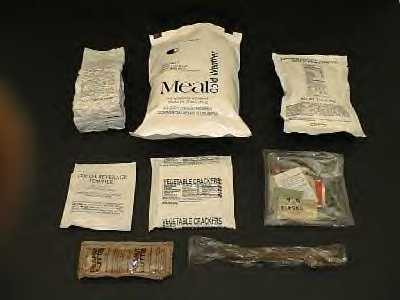 LRP
LRP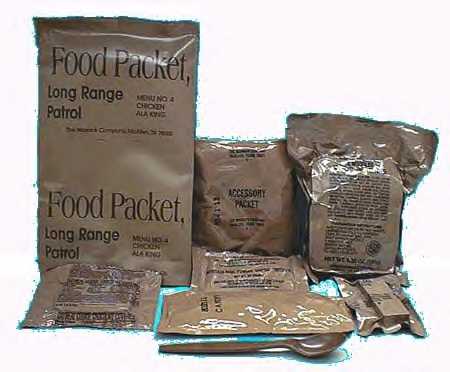
What is it?
The Meal, Cold Weather/Food Packet, Long Range Patrol (MCW/LRP) provides an operational ration for two separate operational scenarios. The Meal, Cold Weather (MCW) is intended for cold weather feeding, it will not freeze and supplies extra drink mixes for countering dehydration during cold weather activities. It can be issued at three per day for a complete cold weather ration. The MCW is packaged in a white camouflage pouch similar to the RCW. The Food Packet, Long Range Patrol (LRP) is a restricted calorie ration meant for special operations, where resupply is not available and weight and volume are critical factors. It is issued at one per soldier per day for up to ten days. The LRP is packaged in a tan camouflage menu pouch similar to the current MRE. The combined product assembly consists of twelve ration/meals packets per shipping container. The weight of each case is approximately 15 pounds and it measures approximately 1.02 cubic feet.
What's in it?
The twelve menus contain dehydrated entree items as well as other accessory items. Each menu provides approximately 1540 kilocalories (15% protein, 35% fat, and 50% carbohydrate). One menu bag is used for the LRP, which is a restricted calorie ration that is designed to be used as one menu bag for one individual per day. The MCW requires three menu bags per person per day and provides for 4500 kilocalories that is necessary to replenish loss of energy from exertion in extreme cold.
How do I eat it?
The individual prepares the food. An average of 34 ounces of water is required to hydrate all components in the average individual menu bag.
How long will it last?
The shelf life is 3 years at 80 degrees Fahrenheit.
How can I order it?
The NSN for the MCW portion of the combined ration/meal is 8970-01-467-1753. For the LRP portion it is 8970-01-467-1749. Point of contact is at (215) 737-8523, DSN: 444-8523, or to e-mail, Click Here.
We can only sell Operational Rations (MREs, UGRs, etc) to the U.S. Military Services and other authorized federally-funded agencies. We can not sell to the private sector (individual, business, or other organizations). For further information, please click here and read our Customer Eligibility Policy towards the bottom of the page.
Comments
Please note that acquisition of the RCW and LRP for the U.S. military services has ceased. The requirements of these two rations are being met by the Meal, Cold Weather (MCW)/Long Range Patrol (LRP) Combination Ration..
| Menu 1 | Menu 2 | Menu 3 | Menu 4 |
| Spicy Oriental Chicken w/Rice | Beef Stroganoff w/Noodles | Sweet & Sour Pork w/Rice | Turkey Tetrazzini |
| Fruit Bar | Chocolate Sports Bar | MRE Crackers | Fudge Brownie |
| MRE Crackers | Peanut Brittle Bar | MRE Peanut Butter | MRE Crackers |
| MRE Peanut Butter | Nut Raisin Mix | Soup, Noodle, Ramen, Instant | MRE Cheese Spread |
| MRE Beverage Base | Cocoa Beverage Powder | Cocoa Beverage Powder | Orange Beverage Base |
| LRP: Accessory Pack A
MCW: Accessory Pack D |
LRP: Accessory Pack A
MCW: Accessory Pack D |
LRP: Accessory Pack A
MCW: Accessory Pack D |
LRP: Accessory Pack B
MCW: Accessory Pack E |
| Spoon | Spoon | Spoon | Spoon |
| Menu 5 | Menu 6 | Menu 7 | Menu 8 |
| Chicken & Rice | Lasagna w/Meat & Sauce | Beef Stew | Spaghetti w/Meat Sauce |
| Fruit Bar | Nut Raisin Mix | Cake | Nut Raisin Mix |
| Soup, Noodle, Ramen, Instant | Toaster Pastry | Chocolate Toffee Roll | Toaster Pastry |
| Orange Beverage Base | Shortbread Cookies | Chocolate Covered Cookie | Chocolate Disks |
| Cocoa Beverage Powder | Cocoa Beverage Powder | Cocoa Beverage Powder | |
| LRP: Accessory Pack A
MCW: Accessory Pack D |
LRP: Accessory Pack B
MCW: Accessory Pack E |
LRP: Accessory Pack C
MCW: Accessory Pack F |
LRP: Accessory Pack A
MCW: Accessory Pack D |
| Spoon | Spoon | Spoon | Spoon |
| Menu 9 | Menu 10 | Menu 11 | Menu 12 |
| Beef Terriyaki w/Rice | Western Omelet | Scrambled Eggs w/Bacon | Western Omelet |
| Shortbread Cookie | Cream of Wheat Cereal | Flavored Oatmeal | Flavored Oatmeal |
| MRE Crackers | Granola Bar | Nuts, Dry Roasted | Fudge Brownie |
| MRE Peanut Butter | Peanut Brittle Bar | Fig Fruit Bar | Granola Bar |
| Orange Beverage Base | Orange Beverage Base | ||
| Cocoa Beverage Powder | Cocoa Beverage Powder | Cocoa Beverage Powder | |
| LRP: Accessory Pack C
MCW: Accessory Pack F |
LRP: Accessory Pack A
MCW: Accessory Pack D |
LRP: Accessory Pack A
MCW: Accessory Pack D |
LRP: Accessory Pack B
MCW: Accessory Pack E |
| Spoon | Spoon | Spoon | Spoon |
| Accessory Packet A | Accessory Packet B | Accessory Packet C | Accessory Packet D | Accessory Packet E | Accessory Packet F |
| Coffee | Coffee | Coffee | Coffee | Coffee | Coffee |
| Cream | Cream | Cream | Cream | Cream | Cream |
| Sugar | Sugar | Sugar | Sugar | Sugar | Sugar |
| Chewing Gum | Chewing Gum | Chewing Gum | Chewing Gum | Chewing Gum | Chewing Gum |
| Matches | Matches | Matches | Matches | Matches | Matches |
| Hot Sauce | Hot Sauce | Hot Sauce | Hot Sauce | Hot Sauce | Hot Sauce |
| Hand Cleaner | Hand Cleaner | Hand Cleaner | Hand Cleaner | Hand Cleaner | Hand Cleaner |
| Toilet Paper (2) | Toilet Paper (2) | Toilet Paper (2) | Toilet Paper (1) | Toilet Paper (1) | Toilet Paper (1) |
| Salt | Salt | Salt | |||
| Beverage Base | Beverage Base | ||||
| Tea (w/sweetener & lemon flavor) | Tea (w/sweetener & lemon flavor) |
What does Natick say about RCW/LRPS? That they are BETTER THAN MRES!
www.natick.army.mil/about/pao/2001/01-57.htm
U.S. Army Soldier & Biological Chemical Command
U.S. Army Soldier Systems Center-Natick
Public Affairs Office
Kansas Street
Natick, MA 01760-5012
Contact: Jerry Whitaker -- Chief, Public Affairs Office
(508) 233-5340
Jerry.Whitaker@natick.army.mil
Date: November 7, 2001
No: 01-57Extreme conditions require different kind of rations
Natick, Mass. --- Two special-purpose combat rations developed by the Department of Defense Combat Feeding Program at the U.S. Army Soldier Systems Center (Natick) have merged into a single product called the Meal, Cold Weather/Food Packet, Long Range Patrol (MCW/LRP).
The new item streamlines production and provides greater operational flexibility compared to the Ration, Cold Weather used by soldiers in frigid climates and the Food Packet, Long Range Patrol (LRP) consumed by Special Operations Forces, which shared the same primary components.
The meal/packet expanded the variety to 12 menus from the Ration, Cold Weather's six menus and LRP's eight menus. Besides all-white packaging for cold weather locations and tan wrapping for special operators, the product is nearly identical. Still, the features of the product serve different needs. The original Food Packet, Long Range Patrol was first issued in 1964 and was popular with soldiers in the Vietnam Conflict, according to Vicki Loveridge, food technologist and project officer for the new meal/packet. The LRP was designed for troops in operations without resupply for up to 10 days issued at one or two packets for each Soldier per day.
Each packet contained about 1,100 calories consisting of a pre-cooked, freeze-dehydrated entrée in a reconstitution package as the main component, candy, cereal or fruitcake bar, coffee, cream, sugar, toilet paper, matches and a plastic spoon. Five menus also included a cocoa beverage.
"Freeze-dried foods have a fresher flavor than canned food," Loveridge said. "It's essentially frozen, where the water has been removed. Food tastes better because there are less physical and chemical changes."
Freeze-dried food can be eaten as is or rehydrated with hot or cold water. It's resistant to storage damage, and with vacuum packing, the entrees have a shelf life as long as 20 years, according to Loveridge. The new MCW/LRP meets or exceeds the military's shelf life standards of three years at 80 degrees F or six months at 100 degrees F. The process also makes the food lighter and easier to carry.
"Food is one of the things Soldiers will discard to save weight and space," she said. "They'd rather carry more ammunition."
By 1983, the Combat Feeding Program created the Food Packet, Assault for the marine Corps that was never fielded but became useful in developing the Ration, Cold Weather.
Marines wanted a lightweight, high-density food packet issued one per day for each marine on missions without resupply. Prototypes consisted of a variety of dehydrated and compressed bars that totaled about 1,500 calories. Although it had been approved for purchase, the Food Packet, Assault was too expensive. The LRP reserves had dwindled during the 1980s, but there was still a demand for a restricted-calorie product to sustain troops during initial assault, special operations and long-range reconnaissance missions.
By 1994, a new LRP ration was introduced. The newest entree package eliminates the old rehydration pouch placed inside an aluminum foil and polyester barrier pack. Soldiers can pour water directly into the brick-shaped pouch holding the food.
The new MCW/LRP weighs 1 pound compared to the Meal, Ready-to-Eat's (MRE) 1 1/2 pounds, and it's compatible with the MRE production. "It's designed so you can have a good meal without extra weight and bulk," Loveridge said. "You're getting 8 ounces of entrée with the MRE, but a rehydrated LRP provides 16 ounces of food. Special Forces like that because they feel full at least once a day."
That's important because one packet of the new LRP contains 1,540 calories and is intended to give the special operator his food each day for up to 10 days. A study in 1992 conducted with Rangers by the U.S. Army Research Institute of Environmental Medicine, an installation partner at Natick, concluded that the extra calories provided by a LRP ration over a 1,200-calorie MRE can make a critical difference in physical performance and immune function.
"In addition we've learned that they're not nutrient-deficient under these extreme training conditions. They're calorie-deficient," said Loveridge. "They want something lightweight and nutritionally-balanced, and this meets those demands."
Marines who deployed to Norway on NATO training missions faced several problems with the MRE. The entrée pouches, then not designed to withstand freezing and thawing, leaked.
Furthermore, Loveridge said marines who ate the cold meals experienced hypothermia and dehydration. A different ration was needed.
The prototype Arctic Ration was first designed in 1981 to provide marines with a lightweight, compact and high-caloric meal for assault, reconnaissance and other non-resupply missions in frigid weather. Another early prototype consisted of three packages.
The main meal pack contained two packages of freeze-dried entrée bars, oatmeal, two plastic spoons and an accessory packet. The other two packages were for a drink or soup, and snacks. The entire ration provided a minimum of 4,500 calories. The Arctic Ration eventually became the Ration, Cold Weather and is used by the marine corps in NATO exercises and Army units in cold climates, such as Fort Drum, N.Y. and Alaska.
Freeze-drying's major advantage besides low weight is low-moisture (2.5 percent compared to the MRE's 40-80 percent) that practically eliminates any chance of it freezing. Other important features of the ration are reduced sodium and protein levels because studies indicated that lowering them reduces the body's need for water. If all the components are hydrated, 90 ounces of water is consumed.
"This gives (troops) a point to start with in water discipline," Loveridge said. "You still need to drink extra water in cold climates. We want to encourage water and calorie consumption, giving them ready-to-eat foods so they can eat on-the-move and rehydratables to maintain water balance."
The Ration, Cold Weather contains a day's ration in two bags weighing 2 3/4 pounds. Troops in cold regions will now be issued three packs of the new Meal, Cold Weather, but its packaging is useful in situations where only one meal is desired, which gives units feeding flexibility, according to Loveridge.
Since it would take four MREs to get 4,500 calories, the MCW is still significantly smaller and lighter.
Customers have been pleased with the results. A Navy master chief at the Naval Special Warfare Detachment in Kodiak, Alaska, wrote Loveridge in June to praise the new MCW.
He said that in 21 years of service it was the best field ration he has used and that he looks forward to giving them to the troops.
Loveridge said future changes to the Meal, Cold Weather/Food Packet, Long Range Patrol may include switching to a single pale-green color for easier procurement, standard use of a peel-open seal for the entrée, and replacement of peanut brittle bar and granola bar with products that have a longer shelf life. Natick is part of the U.S. Army Soldier and Biological Chemical Command (SBCCOM). For more information about SBCCOM or the Soldier Systems Center (Natick), please visit our website at http://www.sbccom.army.mil.
Why the MRE cannot be like RCWs/LRPs and without the constipation effects is a question that needs to be answered. British Royal Marine Wheen didn't like his dehydrated rations in the Falklands:
..and a very little dehydrated food which was useless as it needed cooking!"
Certainly as a Brit, they like their tea and want hot food whereas an America who wants fast food here and now is utterly satisfied with a dehydrated meal brought to life with a squirt of water.
Yes, MREs have improved in their food variety and somewhat less clutter in packaging with the accessories all in one little pack. What remains to be explained is the preservative odor you smell when you open a MRE main course and the constipation it gives you after you eat it. The only thing Sparks will eat out of MREs is the civilian food items inserted AS-IS from civilian life that he knows the military has not given a shot of kayopectat equivalent compound.
We'd like to see the MREs lightened up by Mountain Home dehydrated food and the constipation causing substances removed.
Good Dehydrated Factory Food = 1 year deployment overseas
We can determine the ideal bypass the MRE formula.
We know you will deploy for 1 year. That's 365 days. Obviously you are not going to be in the field that long but let's use that as worse-case.
Some will only need 1 Mountain House meal a day to survive without MREs, but lets also compute 2-a-day.
That's either 365 or 730 Mountain House meals for 1 person.
How much would this weigh? Let's say 4 ounces dry.
4 divided into 365 = 91.25 pounds
So for 2 a day = 182.50 pounds
It seems to me you could easily place 365 Mountain House food packettes into a foot locker and deploy with it to a combat zone and not have to go to the DFAC where you'll get blown up by an enemy attack or slowly killed by what they cook. You could CERTAINLY supply yourself with decent food during field operations and reject MREs.
I'm thinking use a plastic foot locket that's actually a tool chest WITH WHEELS so you can TOW IT through the airport if you can't have it shipped with your unit's gear.
Got Fortified Walls? Enough armor on your vehicle? Then, WHY are we throwing away all these MRE cartons?
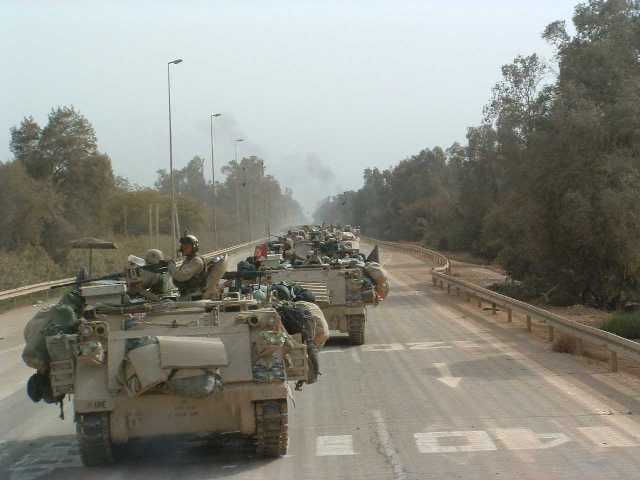
Sapper Company Commander's M113 Gavin Combat Report from Iraq:
"My company attacked with the Task Force (TF) in every major battle with XXXXXX. We were either 2nd or 3rd in the order of movement (OOM) for every battle but one in which we were 4th. We were in the middle of the action. Even though our light tracked M113A2s could go off-road, if we did, a M1 Abrams heavy tank would 'eat it' and get stuck, so we stayed road-bound for their sake. I'm not sure of this but I'd say my M113's ate more RPGs and small arms than any other deployed to Iraq to date. We made several modifications that I'm convinced saved the lives of 5-10 Sappers because we were able to 'absorb' RPGs in a very unconventional manner. We basically made our M113's mobile fighting positions by welding together storage racks and bolting them to the outside of our vehicles. We then filled them with equipment and supplies to create 'baffling'. If we ate a case full of meals, ready-to-eat (MREs), we took the empty box and filled it with dirt and placed it back in the external racks to provide extra ballistic protection. When RPGs hit, they would hit a rucksack or a hard equipment case and go off, and fail to do more than gouge a hole in the vehicle's side.
As it was all we had just 6 Soldiers wounded, 4 were shot by AK47s and two had mortar shrapnel wounds; pretty good all things considered but could have been prevented if we had more gunshields on the top of our M113s like the Israelis have. Even after the 'war phase' was over, I always rode from base camp to say Baghdad International Airport in my M113 instead of a wheeled HMMWV, why risk your life on a roll of the dice?"
Americans are very wasteful yet wonder why they are lacking in armor protection and getting blown up in our absurd tent cities and Humvee/Stryker trucks. Just look at the mountains of MREs held in cardboard cases that will just be thrown away or burned when they are actually BETTER SAND BLOCKS with Lego-like structure that can be stacked to form protective walls and not need things to keep them from falling down (revetments) than current shapeless sand bags. Dirt inside MRE cases make excellent "armor tiles" to line the insides and outsides of armored fighting vehicles like M113 Gavins to withstand RPGs and roadside bomb blasts. We saw this potential back in 1992 and tried to get the Army to exploit it by coating the MRE case with some waterproofing so they could act like sand blocks.
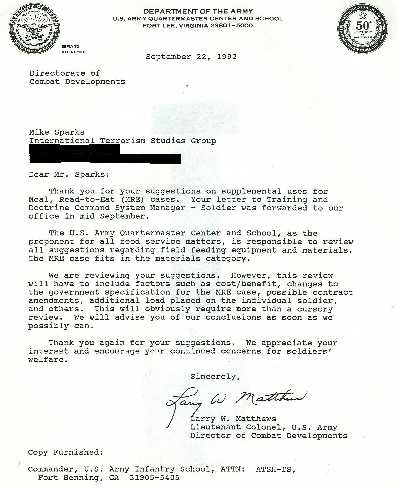
However, as you can see from the letters above, we couldn't get them to "think out of the box" literally and figuratively! Its ironic and hypocritical that people in the military pontificate about how they want to "link" together their little bureaucratic empires in a hand-hold-hands, cum-by-ya (see photo below) but their minds are incapable on LINKING TOGETHER EXISTING EQUIPMENT IN NEW WAYS.
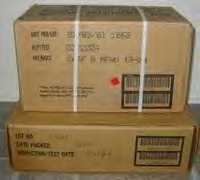
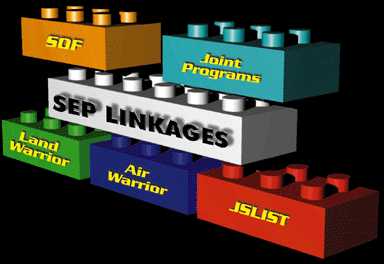
They could not see the MRE ration case outside of its primary function as a container for food, so they in typical bureaucratic, pass-the-buck shipped the idea to the "loggies" when it should have been considered by the Sappers--Combat Engineers the people who blow things up. If the Sappers liked it then the loggies would have to "sign off" on the idea and waterproof-coat coat MRE cases since the MRE is ":their baby". Talk about narrow mindedness!
The thing that occurs to us today is that there is now waterproof coatings like Envirotac's "Rhino Snot" that can be sprayed on the outside of dirt-filled MRE case walls to seal them from moisture so there is now no need for the Army bureaucracy to get off its ass and do something, all we need is for units to realize MRE cases can be used as sand block fortifications, to save them and flatten them so they can accumulate a sizable number and then have them train and experiment on how to use them. Afterwards, they spray the Rhino Snot and voila! They have self-help fortifications that will help keep them alive on the lethal, non-linear battlefield.
MRES for FOOD, how about water?
Another discovered use for MRE ration cases is to transport WATER bags so you don't get stuck with dozens of empty 5 gallon plastic water jugs:
www.combatreform.org/waterbags.htm
How about MRE ration cases for waste water?
During movement in an armored vehicle, you simply cannot stop an entire column just so people can relieve themselves. Now its true that M2 Bradley rear door firing ports should have a relief tube set up. M113 Gavin rear doors within the rear ramp should have a firing port which can also facilitate a relief tube. But this will take HQDA, an outfit that doesn't give a "crap" about Soldiers to worry about crap, when they don't even care about LIFE by supplying ALL our Soldiers with fully-protective TRACKED armored fighting vehicles so they do not die in a flimsy wheeled truck. One solution is to buy a LOT of kitty litter and pour it into a trash bag-lined MRE ration case so Soldiers in the vehicle can urinate into it without forcing the vehicle into a dangerous stop so they can get out. The more you are exposed on foot, the more likely you can get hit and killed by enemy fire. If you have an armored vehicle, use it. Dismounted movement should be only for those situations when a significant tactical advantage is to be gained by spreading out your shooters over a larger area and to get into positions that even a tracked AFVcannot get into. The MRE case can even be used for solid waste material though a 5-gallon bucket adapted with a toilet seat cover would be better.
PART 2: THE DFAC
Poison in the Melting Pot that does not melt: a generation of Soldiers and marines that don't know what "Right Looks Like".
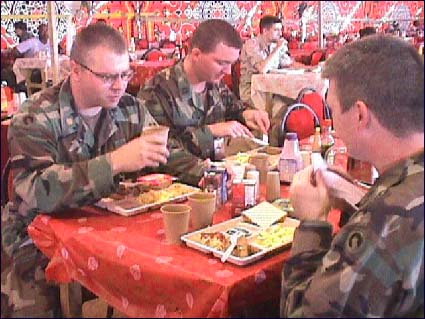 +
+ 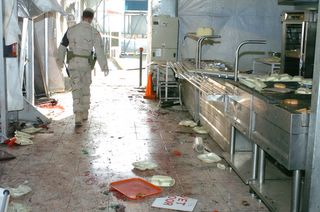 = DISASTER
= DISASTER
"An Army Marches on its Stomach".
--Napoleon.
"Its the food! Its what we put IN to our bodies that is what's killing us".
--Bill Mahrer; "I'm Swiss", HBO TV, August 16, 2005.
To win a counter-insurgency war when you are morally in the wrong occupying a country that does not belong to you whose populace have turned against you requires an exceptionally outstanding army and marines that America does not have nor is deployed to Iraq. On the non-linear battlefield, where the enemy can attack in any direction at any time, having slightly above average ground forces who operate by a routine like its a 9-5 job back home in garrison USA damns us to military defeat. The American military culture in her ground forces is corrupt in all areas and getting worse; servicemen today "do not know what right looks like", and its getting worse with each passing day. In previous white papers we have outlined how the U.S. military is:
a. Narcissistic and nihilistic about self and not the mission "ego-centric", head is not in the game thinking about warfare until its too late and threat of death is upon them; fatal parameters already set years before limits what even the most brilliant tactician and improviser can do if he existed.
b. Sleepless and unsafe as it wastes time on non-sense.
c. Clueless and unprofessional as it pre-occupies itself with building and lawn care doing 19th century "spit 'n polish "building-centric".
d. Is physically unfit for actual specific combat tasks because it wastes 1/3 of the day on sports PT in t-shirt, running shoes, shorts "vanity-centric".
e. Is overly clothed and susceptible to dehydration resulting in heat exhaustion and strokes without people alert to these conditions.
f. Overloaded trying to carry too much of the wrong gear on each Soldier's backs resulting in a sub-1 mph mobility the enemy with "homefield advantage" of knowing the terrain and caching his supplies can easy ambush us and run away at will at 4-7 mph on foot.
g. Eats poor food and performs inadequate oral hygiene placing them at risk of heart attacks, strokes and bringing home to America a disease that could kill millions of civilians as took place in 1918 after the end of WW1.
h. Drives around in civilian-like flimsy, unarmed, unarmored trucks restricted to roads/trails when they should be in war-like multiple armored layered M113 Gavin light and heavier tracks that have maximum armor protection possible while being able to go cross-country to avoid road ambushes in the first place. The work-around of slapping machine gun mounts and armor is not "working" as the enemy's bomb size and composition has quickly out-classed this make-shift effort..
i. Has perverted the flying machine as a war machine to overly complex, unable to fly continuously "cash cows" operated by egomaniacs off in their own little world oblivious to what's going on around them. The attempted work around of unmanned planes cannot see and investigate to adequately locate and pressure the non-linear enemy 24/7/365 from laying roadside bomb ambushes.
After setting this context, this white paper/web page looks at how the Army and marines are NOT marching well on their stomachs because of the poor food they eat.
Transplanting Garrison Building-Centric Life to Iraq.
VIDEO! See how Americans Eat in Iraq! www.combatreform.org/americanoccupationofiraq.wmv
A shocking Army report not yet released has discovered that troops in Iraq are returning home to the U.S. heavier than they were when they left. The liars and status quo pundits will try to spin this as "muscle mass" gained from having to wear "battle rattle" (an incompetent ass says this who cannot assemble and modify his gear so its not rickety, he just takes what's issued as a weak co-dependent who doesn't give a crap about warfighting and throws it together, then mocks his and the Army/marine's equipment incompetence by a glib expression). This "straining at gnats" to find a "silver lining" in a storm cloud which has none, is both dishonest and dangerous. The truth is that most of the 138, 000 Soldiers and marines in Iraq are hunkered down in base camps eating their anxieties away in civilian contractor-run Dining FACilities (DFACs) with fatty foods (see video clip above). This is exactly what they do here in the U.S. except now there is the fear and boredom factors raising appetites to higher levels as activity is diminished to avoid exposure to the rebel's bombs. The centerpiece lie is the idea of a large breakfast-lunch-dinner that most American civilians do not waste time on as its not necessary or desirable. Most Americans DO NOT EAT OUT AT RESTAURANTS EVEN ONCE A DAY LET ALONE 3 TIMES A DAY WHICH IS WHAT A DFAC IS, a poor quality restaurant/cafeteria. Bottom line is SOMEONE ELSE IS COOKING FOR THE AMERICAN SOLDIER. The average American has to cook for him or herself. So WHY should the American Soldier be pampered with 3 restaurant meals a day and lose self-suffiency to feed himself and creates huge convoy and base camp targets for the enemy in the process? There is a HUGE "Jessica Lynch" style CENTRALIZED TROOP FEEDING SUPPORT BUREAUCRACY in the Army geared towards this BS 3-meal-a-day mentality. Soldiers whose sole reason to exist is to feed other Soldiers! However, for an American garrison military phony who wants the day to go by faster, breakfast, lunch and dinner eats up (pardon the pun) 3 hours of the day. To somewhat compensate and pay for this ill use of time, the military has you wake up earlier so you are sleep-deprived and not alert to eat a breakfast you do not need. What our Soldiers need is more REST from mindless BS and less eating. 1st Tactical Studiers Group Director, Mike Sparks writes: "when I'm on active duty I do not eat in the chow hall, PERIOD. Yes, the food is bad for you, but its simply a waste of time when we have things to do that I will not sacrifice to the gods of the DFAC. The troops go to the DFAC and I will work on things that need to be done before they arrive so we can hit the deck running and actually do combat things. If I can store food in my room in a fridge, I will eat at the end of the day something simple. Needless to say, when a period of active duty is over for me, I lose weight."
The next evil is the centralized DFAC itself, an impersonal STATIC BUILDING that is not capable of deployment to a combat zone (you would think, watch out!) that ties Soldiers and marines into a co-dependency to buildings in general; is it a wonder American troops are rarely in the field and have such poor fieldcraft? Before proceeding, we must point out that eating in the chow hall is a welcome relief from the asshole egomaniacs running the U.S. military. In basic training, its 3 time periods where you can at least be somewhat human. And this is the entire problem with the U.S. military; its a dehumanizing, intolerable "machine" that fails when it runs up against an enemy army that IS HUMAN, that does care about its people and THINKS a LOT about what its doing. We are using chow to work around the fact that our concept of how to get human beings to fight through destroying their inner spirit and making them into co-dependent "sheeple" is corrupt, dangerous and a miserable failure. We point this out, so right up front we admit we know what the "game" is with chow. However, its time we face the problem squarely that we are run by asshole tyrants who have made being an inventive warrior not possible and being in uniform in today's military intolerable..
Furthermore, the current 3-meal chow hall food regimen makes everyone constantly bloated and DIGESTING FOOD ALL THE DAMN DAY! Everyone that partakes of the 3-meal mantra is groggy and listless when we should be DOING THINGS instead of patting our stomachs in a satisfied stupor. We realize there may even be a majority of the Soldiers in uniform today who will violently oppose the elimination of the 3-square meal routine. We understand its an escape from assholes. However, wouldn't you want to be doing exciting Army combat training if we can get rid of the assholes? If the answer is a resounding "NO!" then the hard truth is that we need to get rid of the majority of the people in uniform today and start over with those who want to FIGHT and WIN. The U.S. military should be about COMBAT EXCELLENCE not chow halls and welfare recipients in uniforms.
As you can see, the American military with excess money to throw at problems has indeed transplanted STATIC BUILDINGS to a fluid, mobile situation in Iraq and then insulated itself from what's going on around them just like how it lives here in the U.S. in its fantasy world of "From Here to Eternity" style petty back-stabbing and fuck-you politics of self-advancement. The problem with the DFAC is its builds CO-DEPENDENCY to the supply lines and destroys SELF-SUFFICIENCY which is what you need to win in wars. Its good only if you want weak, sheeple so you can control them for that 3 hours and then spend the remaining time obsessing about their vanity appearance via absurd height/weight charts designed to fool the American taxpayer and Congress that we look the part instead of BEING THE PART of being actually combat ready. Its a giant sham operation. If you doubt this, just go up to any American Soldier and ask him what is the maximum effective range of a RPG in the hands of an average gunner against a moving target? Ask them how it is loaded; do you just load the rocket and fire? The answer is 300 meters and you need a booster charge in the rocket base otherwise it will blow up in your face. The American Soldier/marine does not know his professed profession and does not care to know, either. He believes if he conforms well enough to the machine he belongs in, all will go well for him; he will make middle class wages, rank and get college benefits for later life as a superior-than-thou civilian beating his chest about his "time in the service".
When the U.S. Military Does Go to the Field it uses "Fast Food"
However, the American military has to go to the field from time to time to keep up appearances and fight short, easy wars against push-over nation-state opponents. Its food for these expeditions is also "fast" in the form of the anxiety-ridden Meal-Ready-to-Eat (MRE). The MRE used to be referred to by its official name as a "C" ration which meant only a TEMPORARY FOOD that would be superceded by "B" and "A" rations. The MRE is actually a quasi combination of a "K" ration which is just for immediate stuff-you-face food for combat energy and the "C" ration of WW2 in a plastic packaging form instead of heavier metal cans. We suspect the MRE has a constipation agent in it so you do not defecate in your pants and look unmanly, which is a huge, chief concern in a narcissistic egomaniac culture like the U.S. Army and marines. Better to bind one's bowels for weeks at a time than show you are a "pussy" amongst your peers. Of course this is unhealthy and the MRE is supposedly restricted to just 14 days of use but we all know troops eat them for longer time frames. So Americans "bite the bullet" with MREs rather than cook decent food in the field to eat like other armies do. What this does is create this backlash to get back to base and eat "real food" at the DFAC. Again, another case where the American Army/marines refuse to ADAPT properly to the problem at hand, try to skimp, it doesn't work, so they instead decide to avoid the problem entirely by simply "not doing the field".
The next problem with the MRE is hurts tactical powers because its builds CO-DEPENDENCY to supply lines and destroys SELF-SUFFICIENCY because they no longer have heat tablets to warm and cook food; which means the art of field cooking and boiling has vanished in this current generation that doesn't know what "right" looks like. The flameless MRE heater may be a great way to create hydrogen to fill a marker balloon for Close/Maneuver Air Support, but it cannot boil water or cook food captured or foraged in the field, a dangerous situation and capability loss. There are many things we should do to improve the MRE; get rid of constipation agents, simplify, add a SPORK and micro-hygiene capability via a packette of multi-use soap, a sugarless drink mix that will flavor an entire canteen etc.
Towards a Healthier and Combat Ready American Ground Force.
We have to start spending EVERY waking second of the duty day working towards COMBAT excellence. This means the static civilian buildings must go. Place all trophies, plaques and unit awards in one building for safekeeping and lock the doors. All other administrative buildings must be locked and eventually bull-dozed. This includes eventually troop barracks, we are not running a summer camp or college dorm. All those $BILLIONS we are wasting on buildings that don't fight and keep us away from training and fighting need to be used to buy PORTABLE, battle-hardenable ISO container "BattleBoxes" that EVERYTHING WE OWN GOES INSIDE, so when we need to go to war, we pick them up and GO by container ships, railroads, trucks and aircraft. No more packing and repacking tents that do not protect us from bombs, shells and bullets. Soldiers report for duty in full battle gear EACH AND EVERY DAY at 0800 hours AFTER EATING THEIR OWN BREAKFAST IN THEIR CIVILIAN HOMES/APARTMENTS---to their BattleBoxes arranged in a field setting as we would in war. They train EXACTLY as they should fight and they damn well put an end to their gear "rattling" by DAILY FIELDCRAFT PROFICIENCY. We look the part of a Soldier because WE DO THE PART OF A SOLDIER EVERY DAY. Soldiers wear combat gear not tshirts and shorts, jogging pants etc. At the end of the day you LEAVE THE POST/BASE to eat DINNER and live a real civilian existence so you can stay connected to REAL people not narcissistic asshole egomaniac phonies in the make-believe, military culture. Wars are caused by PEOPLE and if we want to win them we had better understand real people not co-habitat amongst only the economic and ego refugees that flock to an "all volunteer" service with hefty pay and benefits. The ONLY food interruption of daily combat training is LUNCH done at the unit in its BattleBoxes. It will take time before the BattleBox and combat-centric U.S. military can displease and force out the assholes who want to play "From Here to Eternity" instead of "Band of Brothers", but its a start. .
There would be no non-combatant wheeled trucks; frauds like the quasi-armored Humvee and Stryker would be gone. Everyone fights and Everyone works. Just as Heinlein realized in 1958 in his book, "Starship Troopers". Officers lead-by-example meaning they are in combat gear each day with the men operating from self-sustaining BattleBoxes and Tracked Armored Fighting Vehicles (TAFVs) not some polished floor egomaniac building. We should start with a Non-Linear Maneuver Brigade (NLMB):
Food from a Pack not a DFAC!
There would be NO DFACS!
They would all be torn down. Troops would eat from a designated Company-level Field Kitchen BattleBox when at the simulated Forward Operating Base (FOB) and in a communal way from their tracks and packs on maneuver operations. ALL Soldiers of ALL ranks would take turns manning the BattleBox kitchen for lunches and special events ONLY during CONUS operations. When deployed in a war zone, breakfast would still be on you and dinner from the company BattleBox serving line--grab & go back to your own BattleBox to stay DISPERSED and not present a huge target for the enemy to kill in one strike. There will be no one who plays just the role of "cook" and suffers the resultant snobby condescension. Everyone fights! Everyone works! The world's best army units, the British and French Foreign Legion know that to train to be combat ready you must get AWAY FROM THE "FLAG POLE" (ie BS buildings and garrison environments) and live in the field constantly. The BattleBox system will enable entire Army units to be picked up without warning and shipped to training areas like Shiloh in Canada by inexpensive rail or container ships overseas so they can train in virgin locations free from the eco-nazis who don't want them hurting a tree. They have stopped pretending to be macho supermen admitted that they are humans and realized how to motivate their men to be a cohesive fighting unit that THINKS about the mission and actually cares for each other as people. The Brits carry heat tabs (hexamine) that burn in a hot blue flame that can heat a small canteen cup or pot for tea from inside a metal "Tommy Cooker" no larger than 6 inches by 6 inches or a Natick Stove. You can place twigs into the cooker or under the Natick Stove to build a small fire, too. Tea has been shown to be good for the body and is a morale booster. When a designated Soldier "brews up" he feeds the others in his section in an act of unselfish camaraderie lacking today in the institutionalized American Army and marines. The French and Russian Armies even offer heat tabs and stoves with their rations!!!
Kinton Connelly's excellent MREINFO.COM web site reveals the following about the British and French Army rations and some excellent ideas we should incorporate into our MREs like the 25 meter target and range card, boil-in-a-bags, water purification tablets and powdered soups:
www.mreinfo.com/british-rations.html
EXCERPTS:
"The breakfast, main meal and dessert rations are of the boil-in-a-bag (retort pouch) variety and can be heated up by submerging them in boiling water heated up on a Hexamine Stove (see below). The soup and drinks are in instant and/or powdered form."
"One useful feature of the GP rations is on the box itself. As you can see from this picture, each box has a target and range card printed on the side."
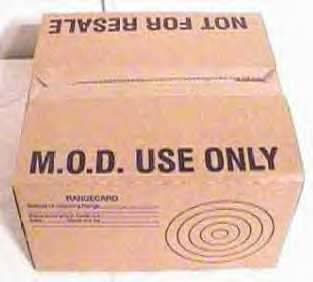
"1 x Soup, powdered form, in sachet (varying flavours; Beef & Tomato, vegetable, Cream of mushroom, etc, manufactured by "Chequer Foods Ltd")"
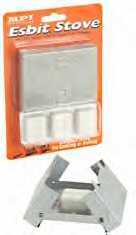
"British Soldiers are issued Hexamine stoves, also called Tommy Cookers. These pocket-sized, foldable, solid fuel metal stoves use blocks of hexamine for fuel. These stoves be can used to heat up water for coffee/tea and to warm up the entrees. They also come with an adapter to hold a metal mug/canteen cup. These stoves are similar in design to the European Esbit stoves but are larger and come with different fuel. They come issued in a brown paper wrapper with 8 fuel tablets in a waxed box. The standard issue is one cooker every three days but with fuel refill every day. The fuel with these is very toxic, smells dreadful and very difficult to light as it is very waxy. Despite all this the smell of it on a cold morning is beautiful!
Some of the pictures show the mug adapter, which fits on the top and holds the relatively new issue "Crusader" metal mug. The normal issue mug that comes with the water bottle is plastic and fits on top of the bottle. The metal "Crusader" mug fits underneath the bottle."
The French Army's RCIRs are amazing:
www.mreinfo.com/france.html
EXCERPTS:
"France uses a ration called the "Ration de Combat Individuelle Rechauffable" (Combat Ration Individual Reheatable), or RCIR. A single ration contains 3200 calories and is intended to provide the nutritional needs for one soldier for one day. RCIRs are delivered in boxes of 12 rations. A single pallete of RCIRS will contain 20 boxes or 240 RCIRs.
There are 14 menus in all and they are divided into two types:
- Menus without pork, numbered from 1 to 7,
- Menus with pork, numbered from 8 to 14.
"Here's a look at the disposable folding stove included in each RCIR. Also included are 6 esbit fuel tablets and matches."
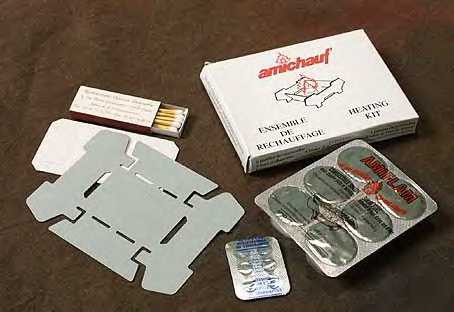
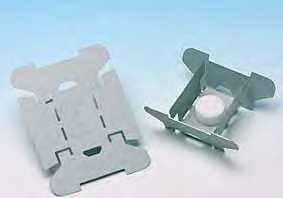
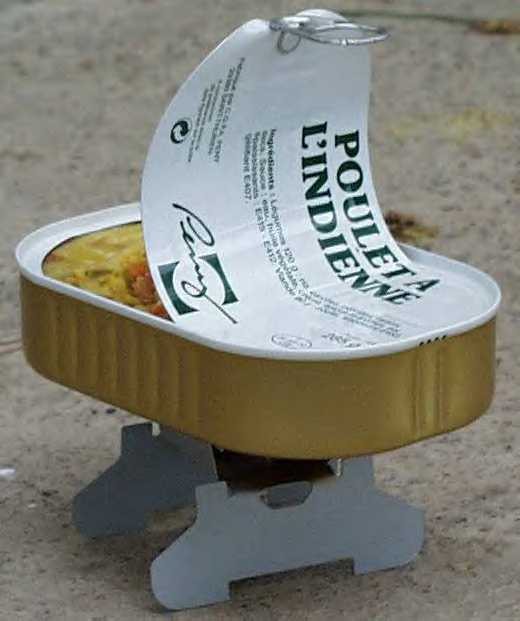
"Some Soldiers have reported that the trading value of RCIRs when on exercise with MRE eating troops is 1 RCIR for 5 MREs on average. In Somalia, a crate of RCIRs would get you a US field cot."
As you can see, the French Army ration is very well-conceived:
* water purification tablets (like smart Brits and Russians)
* condensed milk (Sparks must have this)
* Disposible ESBIT stove with ESBIT heat tabs (brilliant feat IMHO)
* Better food than American MREs
* Ingeniuous DISPOSIBLE ESBIT heat tab ration heater
Other WWW.MREINFO web pages show the Russian Army rations have a neat stove and a multi-vitamin and can opener offered:
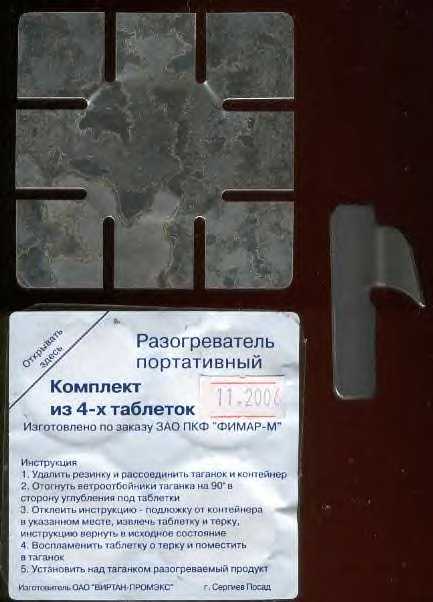
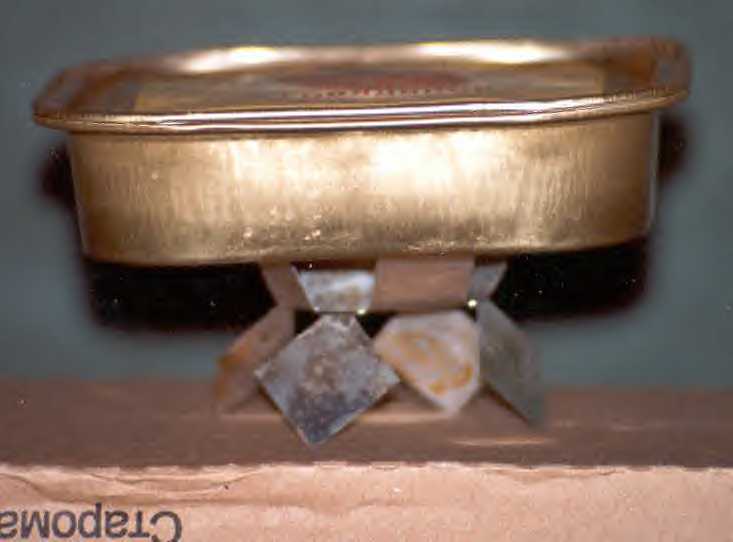
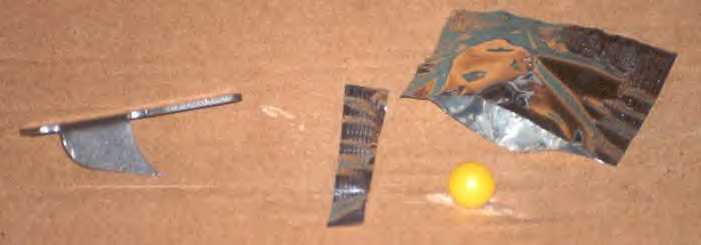
Thus, the British, French and Russian Soldier can COOK his own food and American Soldiers/marines cannot unless they supply themselves the necessary means. The French Foreign Legion are like the British but better, they make eating in the field a high art and at the end of an operation they hold a feast in celebration cooked by their "Chefs" who they hold in high regard, whereas in the American military cooks are held in contempt as "pussies" who don't fight etc. etc.

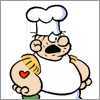
When Napoleon said an army marches on its stomach, the conclusion for the American military then is we hate our stomachs and those that feed them. This must change.
American Combat Melting Pot Concept: Function must come before Form.
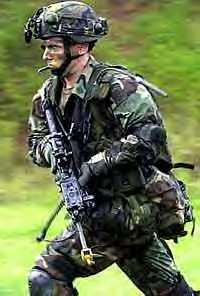
We propose that every 4-man fireteam be issued a Tommy Cooker or other suitable small stove with a small cooking pot with lid and heat tabs be reintroduced back into the IMPROVED, REAL FOOD MRE. (See below for G.I. Field Cooking 101 staff study). We think the MRE should be composed of DEHYDRATED, FREEZE-DRIED FOOD LIKE THE RCW/LRP is. One Soldier would be designated as the "field cook". In a continuous 24/7 operation, he would perform the following cooking tasks:.
Breakfast: cook a light COMBAT SOUP using lightweight dehydrated noodles for everyone in his fireteam to walk by and dip their canteen cup (think Hackworth's canteen cup in Lean & Mean) into his small pot to get the unit's brew. Soldiers can eat a MRE if they like or get by just on the COMBAT SOUP. Emphasis is to get ON THE GO without energy loss through digestion, to be alert WITHOUT CAFFEINE after a restful sleep punctuated by sound security procedures that evenly divide the work-load.
Lunch: cooks a light, sweet TEA for everyone to get a cupful to go along with whatever they are eating from the MRE.
Dinner: cooks a rice that Soldiers contribute a MRE or other food part into a communal "STEW". This is the big meal of the day for energy for the upcoming night security and possible movement operations.
SOUP-TEA-STEW would be the new American military diet.
The benefit of having at least one Soldier COOK (boil, heat water and make food safe to eat) is that it opens the door to forage (collect) food from the land itself to FREE THE UNIT FROM CO-DEPENDENCY ON THE SUPPLY SYSTEM TO CREATE BOLD, INDEPENDENT MANEUVER. The Brits in Malaya would take lightweight cooking gear on 30-day dismounted patrols and a basic rice supply that they added small animals and vegetables from the field such that their movements could not be anticipated by the rebels. They were completely independent in their maneuver options. Yes, the designated field cooks should go to a formal SERE school and nature food recognition courses to bolster their ability to forage to feed the fireteam pot safely and with a great taste.
Combat Melting Pot the Staff Study: U.S. G.I. Field Cooking 101
Our goal is to cook 3 times a day, for a 4-man fireteam. We are not necessarily asking the U.S. to be as aggressive as the British, French and Russian armies are about supplying heat tabs and stoves to EVERY INDIVIDUAL SOLDIER. We are proposing a heat source for every 4 men to create a "Combat Melting Pot" effect. The fireteam chef offers in the morning soup, the afternoon tea and dinner, rice. What do we have to work with now?
G.I. Steel Canteen "Cup" that actually holds 2 3/4 cups
G.I. Aluminum Natick Stove
G.I. 1 quart canteen
No heat tabs
As you can see, with the advent of the flameless MRE heater you are not supplied by our government in a way to boil water or cook food!
The first self-help is to BUY HEAT TABS for your Natick Stove. If you cut the heat tab in half before burning you can get by with 3 halves per day. So for a 30 day supply x 1.5 = 45 heat tabs. You can burn twigs in the Natick stove if you are out of heat tabs, but if you are in the desert without any tree wood to burn you are hurting. If you are so hot and miserable in the desert you might ask, why do we need any more heat to add to our discomfort? The soup, and instant tea need a bit of warmth to taste good and to raise morale. If water is hot already from desert sunlight you can just pour it into canteen cup, but in the morning for the soup it might require a heat tab half. This is also true for Mountain Home dehydrated foods which are actually the CWR/LRP rations in G.I. disguise. The problem is the canteen cup ONLY MAKES ENOUGH FOR AT BEST TWO PEOPLE, and we need 4 people fed. This problem gets worse when you want to cook the rice dinner.
Rice Formula = 2 parts water + 1 part rice
So you can see the canteen cup can only make enough rice <1 cup for 1 at best 2 persons because the 2 cups of cooking water gobble up the space inside.
G.I. Canteen Cup Measuring Cup
You can take a black permanent marker and add lines to your G.I. canteen cup to indicate where to fill rice and water.
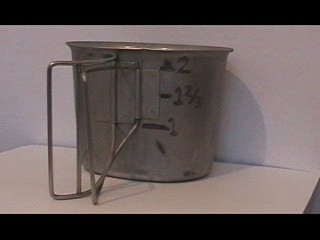
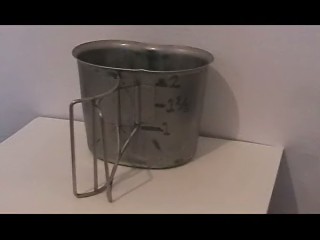
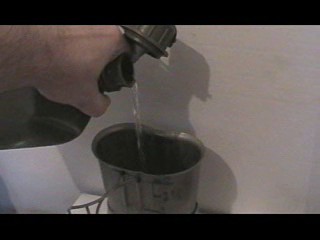
Canteen Cup Cooking: Just enough for 1 person
If you reduce water and rice so it can expand and cook in a canteen cup (less than 3/4 cup of each) you end up with only enough rice for 1 person and will need to find some way to cover the cup as it cooks.
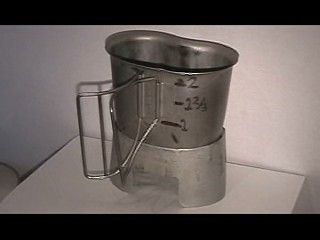
Summary/Conclusion on G.I. canteen cup/Natick Stove combo
IF we change our field cooking concept from the 4-man fireteam to the 2-MAN BUDDY TEAM, the current Canteen Cup/Natick Stove combination will work. We will lose the TEAM morale building effect however. The 2-man buddy team cooking should always be an option however that leader's should specify in their 5 paragraph operations (OPORD) in the Service/Support section. Right now, "MREs for chow" are code words for fuck-you, feed yourself.
We will need a BIGGER POT for the 4-man fireteam field feeding concept. How big?
Where's the Combat Melting Pot?
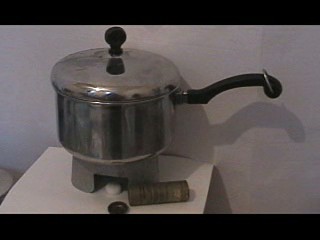
Will the Natick stove heat up your 48 ounce Combat Melting Pot? Yes, but it will take an entire heat tablet. You can still get by on soup and tea with just half a heat tab to warm them, so re-compute daily useage rate to 2 heat tabs per day per fireteam. A 30-day supply = 60 heat tabs total.
The Ideal Combat Melting Pot (CMP)
The ideal 48-ounce (1.5 quart) CMP would be teflon-coated on the inside and perhaps outside, too because we don't want shiny stainless steel reflecting glint and giving our presence away to the enemy. Of course, the canteen cup and Natick stove are themselves a dull finish steel and not too camouflage friendly, either but civilian camping gear tends to be VERY SHINY reflective steel. The CMP should have marking on the outside for 1, 2, 3, 4 cups etc so its its own measuring cup so we do not need the G.I. canteen being clean and ready to help out. It should have a pour spout on one end so soup and tea can be poured into the fireteam member's G.I. canteen cup as they walk by for their portion of egalitarian teamwork and sustenance. The entire CMP should fit into its own pouch by its handle folding so it can be carried by the "Fireteam Chef" ON HIS LOAD BEARING EQUIPMENT or without its pouch INSIDE HIS BUTTPACK. We do not want to HAVE TO CARRY RUCKSACKS; soup, tea and rice along with decluttered MREs/CWRs/LRPs should also be in the butt pack, or if the unit has an ATAC, pack-mule or M113 Gavin "mother" vehicle.
The MSR DuraLite(tm) Mini Cookset Item Number: 87833 for $50 looks like it might fit the bill of a CMP though it doesn't have the graduated lines and pour spout....
www.campmor.com/webapp/wcs/stores/servlet/ProductDisplay?productId=31003764&memberId=12500226
Includes 1 and 1.5 liter pots, lid, and PanHandler. Premium, hard anodized, non-stick aluminum cookware for backpackers and climbers. 40% lighter than most cookware. Features MSR's DuraCoat- three layers of MSR's longest lasting, non-stick coating. Includes a PackTowl for cleaning and non-stick protection during transport. Spiral grooved bottom grips stove pot supports. Nests with other MSR cookware for compact storage. Weighs 15.5 oz.
http://convert.french-property.co.uk/index.htm
1.000 litre [l] equivalent to: 35.20000 fluid ounce [fl oz]
An USAF MSGT disagrees with this choice for the CMP:
"I'd avoid Teflon cookware coatings due to potential health hazards. If stainless is too shiny a quick zap with a sandblaster will fix it. (Monument companies are a good place to get things blasted, by the way, since they use a blaster to cut tombstone lettering.)"
The Ideal Combat Stove
Can we afford the heat tablet?
Now let's go back to the heat tabs. These power the Natick Stove which is a great SERE and 2-man buddy team cooking option because it subliminates itself around a 1 quart canteen. Can it cook a 48 ounce pot, yes but this is its maximum. The problem is that the stove has NO BOTTOM so you don't want to put a burning heat tab on the floor of a building you are occupying or an armored vehicle, though you could in a pinch with the latter. There is also the problem of getting the heat tabs---civilians don't use them!
The ESBIT "Tommy Cooker" has a metal pan to burn heat tabs or ESBIT sticks which are widely available through mail order.
www.campmor.com/webapp/wcs/stores/servlet/ProductDisplay?productId=1055&memberId=12500226
Remember, we are only talking about a cooking means for the fireteam chef who would forgo the Natick stove in favor of the Tommy Cooker since he will be brewing up often.
Again, the problem is that the Fireteam Chef Soldiers are having to pay for the ESBIT fuel sticks even if the Tommy Cooker was issued to them. The DoD/Army/marine bureaucracy do NOT look like they are willing to reintroduce ANY KIND OF HEAT TABS back into the supply system. So let's look at the costs of doing it yourself for a 1 year deployment.
Emergency Resources sells 3 trioxane bars for $1.39 or about $0.44 each
www.emergencyresources.com/er_p9.html+nuwick+candles&hl=en&ie=UTF-8
Fireteam
60 heat tabs per month for 12 months = 720 heat tabs @$0.44 and 2 ounces each = $316.80 and 90 pounds in weight.
Squad
2 fireteams = $634 and 180 pounds in weight
Platoon
3 squads = $1, 902 and 540 pounds
Company
3 platoons = $5, 706 and 1,620 pounds
We bought and got the JP-8 why not use it in a stove?
So as you can see, IF we can piggyback/parasite off a JP-8 fossil fuel source from our mother M113 Gavin vehicle, then all we need is to buy 18 x JP-8 stoves and 18 x Combat Melting Pots, a one-time up-front expense. Bought in bulk, the JP-8 stove and CMP should not cost more than $200 together, or $3, 600, which as you can see above is just 1/3 the cost in heat tabs!
So now we have to wait on Natick Labs and Cascade Designs to get their act together and field a JP-8 stove. While we wait, let's look at other stove options and really get confused.
Wood as a Fireteam Stove fuel?
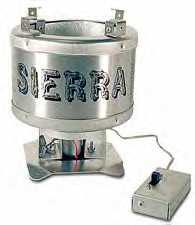
Yes, you are in the desert and there are no trees, but you are WITH THE U.S. military that SHIPS THINGS ON WOODEN PALLETS and "DUNNAGE". If these items are not going to be re-used as they should, all you need is an AX and you could chop up the wood into little pierces to feed your Natick, Tommy Cooker and other stoves. I did say "other stoves". 1-800-CAMPMOOR www.campmoor.com offers a fascinating Sierra ZIP Wood-Burning Camp Stove No. 86111-A $47.99 that is 4 inches by 5 inches and weighs just 1 pound and can boil 1 quart of water in 4 minutes. It needs 1 AA battery I guess for ignition, but we use lots of AA batteries for night vision devices and these can be recharged.
www.campmor.com/webapp/wcs/stores/servlet/ProductDisplay?productId=13930&memberId=12500226
What fuel source DOES the civilian public use? Sterno cans, of course!
Now back to a pre-packaged heat source, this time Sterno in a can. Unlike heat tabs, you can buy it ANYWHERE, KMart, WalMart, camping stores "off-the-shelf". Here is where it gets interesting.
The Kwik-Cook Metal Folding Stove No. 87526 $5.99 can hold a Sterno can or a Nuwick survival 44-hours candle
www.campmor.com/webapp/wcs/stores/servlet/ProductDisplay?productId=13942&memberId=12500226
Includes 3 moveable wicks, 7 oz. of wax to last 44 hours, and matches. 1.5 in. x 3.5 in. Fail-safe source of lighting, heating, and cooking. The innovative technology behind NUWICK is the wick. It's completely independent, moveable, re-useable and waterproof. Each wick will burn 25-40 hours and if more light, heat, or cooking capabilities are needed, you just add another wick, up to 3 wicks max. Only 2 wicks are usually needed for cooking. Specially formulated, non-toxic slow-burning wax is contained in a metal can that won't tip and has a lid for storage. Tweezers, to move wicks, and matches are included.
**********************
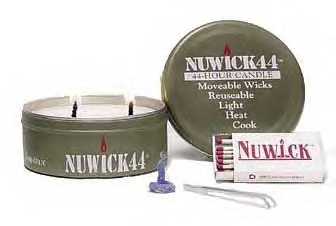
120 Hour Nu-Wick Candle
www.campmor.com/webapp/wcs/stores/servlet/ProductDisplay?productId=13943&memberId=12500226
***********************
which can also cook food albeit slowly whiile providing a light source at night. Using 2 wicks water will boil in 14 minutes. The problem we see with Nu-Wick is SAFETY in say an Ecotat 1-man tent in a military setting--there appears to be no LANTERN that interfaces with it, eliminating one of its huge selling points as a light source. Back to food cooking.
Kwik-Cook however, doesn't have a metal pan to burn twigs/wood like the ESBIT Tommy Cooker can.
www.campmor.com/webapp/wcs/stores/servlet/ProductDisplay?productId=13944&memberId=12500226
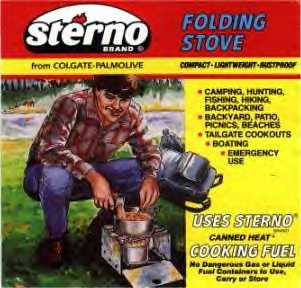
However, the Sterno Brand folding stove can hold a Sterno can, Nuwick candle can and burn wood chips/twigs because it has a metal pan on the bottom. Weight is only 10 ounces and cost is $10.
www.baproducts.com/p62.htm
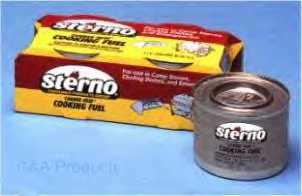
So how much cooking "can" a 7 ounce Sterno can do in our 4-man fireteam mission context? Each can burns for 2 hours. If it takes 4 minutes to boil 4 cups of water, this means you have 15 communal rice dinner sessions per 1/2 pound can. For 30 days, this means 1 pound of Sterno in 2 cans at $8.
Fireteam
2 Sterno cans per month for 12 months = 24 Sterno cans or 12 x 2-packs @$8 and 1 pound of weight per pair = $96 and 12 pounds in weight.
Squad
2 fireteams = $192 and 24 pounds in weight
Platoon
3 squads = $576 and 72 pounds
Company
3 platoons = $1,728 and 216 pounds
We must say Sterno does not look bad at all in terms of cost, weight or safety!.
Natick Stove Modified to sit atop a Sterno Can for a heating source
Sterno is a very cost-efficient and available cooking fuel but requires a fold up square stove of its own. To our surprise THERE IS a way to modify the Natick Stove so it rests securely on top of a can of Sterno to use it as a heating source.
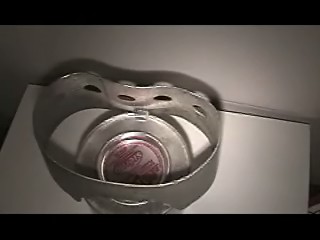
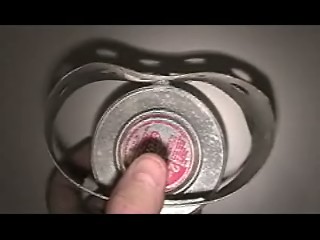
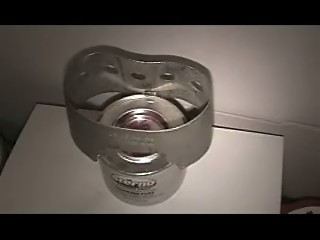
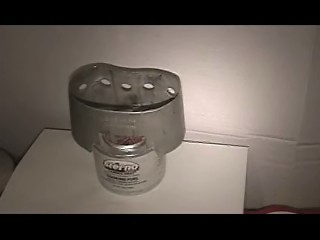
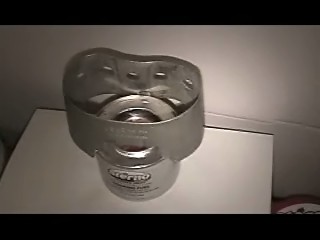
You have to cut out some of the Natick stove at the front so it will rest on top of the Sterno can.
The most difficult modification is taking some metal snips/multi-tool/leatherman and cutting a tab on the back side and then bending it with pliers/multi-tool etc. to rest on top of the Sterno can.
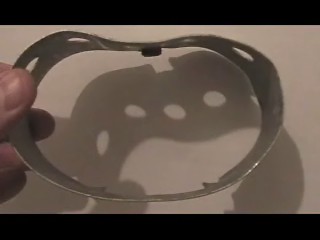
If you file down the notch the 1 quart canteen can still fit inside the Natick Stove for carry inside the canteen cover or better yet an enclosed pouch.
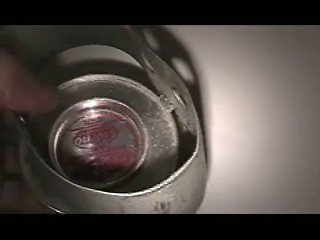
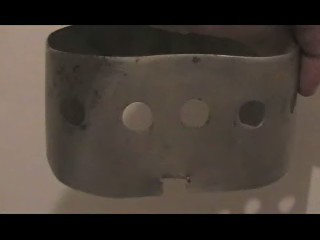
With Sterno you certainly have enough heat to cook using the Canteen cup and a larger 48 ounce pot.
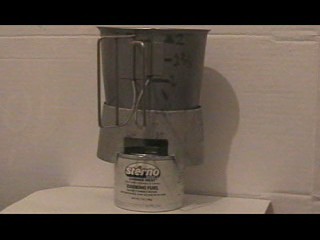
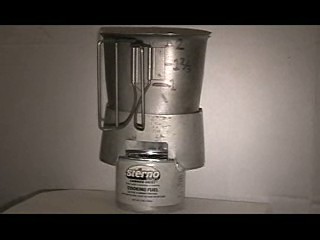
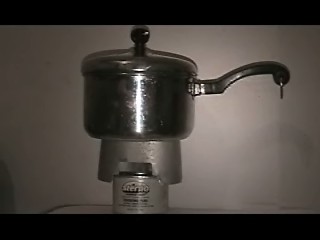
Minimalist Sterno Can Heater
Phil West found this minimalist Heater that can be carried on the Sterno can itself:
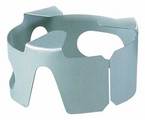
www2.asmc.de/advanced_search_result.php?XTCsid=be5c6047647769657e7d3ab18356353d&keywords=firestar
He asks:
"Is Sterno the only brand of gel cooker you can get and why not use Firestar paste?
www2.asmc.de/advanced_search_result.php?XTCsid=be5c6047647769657e7d3ab18356353d&keywords=firestar
The burner stand clips around the outside of the can -they used to be sold with a stand with each can. The refil paste (or the contents of the can) can be placed in another container (any metal dish really) that will fit in the Natick Stove without modification. According to the ARRSE website:-at least this company still sells gelled fuel: www.topcookware.co.uk/index.htm
(search for "fuel")
www.casawares.co.uk/di...l_fuel/951
They call it "fonheat"
In Germany it´s no problem to get it. If you don´t find it in GB here´s plan B:
www.ranger-online.com/
That´s a German surplus store - a trustworthy one and they have an english version of their website. Just type "firestar" in the search box and you´ll find the needed fuel."
Denatured Alcohol for camping stoves, cheap but is it SAFE?
Another option out there is Denatured Alcohol (DN) which is alcohol with NO WATER in it. Camp-Mor has a "Hike'n Light" alcohol stove that holds 5 ounces of DN alcohol for 1 hour of burning.
www.campmor.com/webapp/wcs/stores/servlet/ProductDisplay?productId=15973489&memberId=12500226
5 ounces of DN alcohol = 1 hour
In 8 minutes, it can boil 4 cups of water for our 2 cups of rice to feed the 4-man fireteam at dinner.
60 minutes = 7 boiling sessions of 4 cups = 7 days of dinner rice = at cost of 5 ounces DN alcohol
10 ounces of DN alcohol = 14 days
20 ounces of DN = 28 days
30 ounces of DN = 42 days
32 ounces = quart = $3 but is 32 OUNCES OF HIGHLY FLAMMABLE ALCOHOL SAFE on the body of a Soldier or in a ATAC, pack-mule or ground vehicle in a military environment?
For 1 month it would cost only $3 and take just 1 canteen quart's worth. For 1 year, this means 12 quarts or 3 gallons of DN alcohol for $10. 2 fireteams would need 6 gallons of DN alcohol at $20 for a squad, a platoon would be $60 and 18 gallons, a company $180 and 54 gallons of DN alcohol. This is 11 x 5 gallon plastic jugs of the highly flammable stuff. Will the USAF let us fly in their aircraft with DN alcohol in 5 gallon jugs?
An USAF MSGT writes:
"Liquid denatured alcohol is a good fuel (and an expedient disinfectant, or if diluted a bit a good aftershave!) but flying with unmanifested flammables in random containers is asking for leakage. If a unit is going to use alcohol, 5-gallon containers within an overpack sealed drum and with Haz Decs prefilled would be the way to fly it over. Solid fuels, candles, etc would not pose a problem."
If you are mounted Cook with the Vehicle: Tank Sergeant Ralph Zumbro
Ralph Zumbro writes:
"Gents,
If you are out in the desert on patrol, to cover any usable distance you are going be mounted. A running Diesel engine keeps its cooling system at 220 degrees, about the same temperature comes off the radiator. You can find up to 1000 degrees in the exhaust system. I have personally heated MRE type rations by tying them behind the carburetor of a 360 Dodge...Mike, you have seen that vehicle.
You can also cut into the radiator hose, slip in a coil of 5/8 dia copper tubing curled down to fit your pot and simply cook on the go. Old tanker's stove was gas or diesel poured into a can full of sand and simply lit. Bottom line is if you have a running vehicle.....It is a stove/oven. Current tankers have been known to simply dent a can of civilian food, and hang it in the exhaust...when the dent pops out, food is done. Next installment will cover expedient solar cookery."
Combat Melting Pot Conclusion: Let's DO TEAMWORK, not just TALK about it.
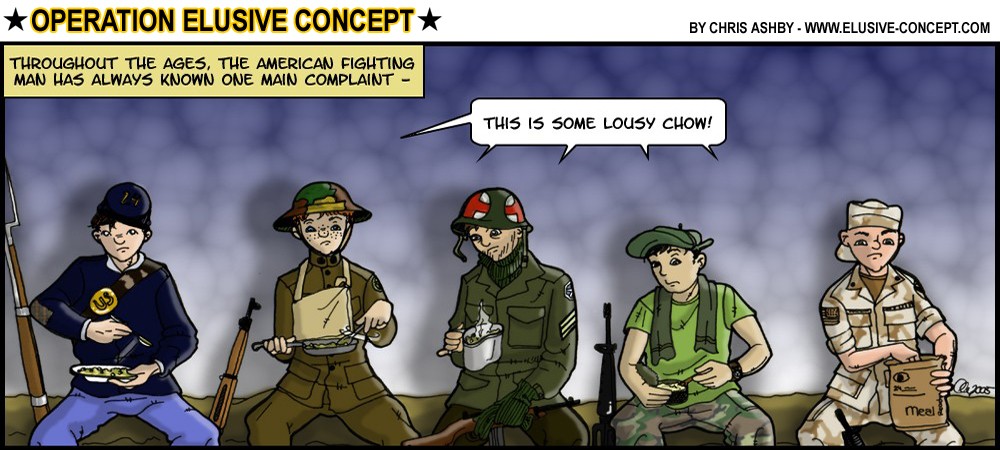
Bad American chow is an American military self-created problem. For more of Chris Ashby's amazing artwork and cartoons: www.elusive-concept.com
The American military talks a great game about "teamwork" while it perpetuates a "fuck-you, I-am-better-than-you" snobby culture of narcissistic egomania for those with rank and badges in a sea of conformity of the unwashed sheeple economic co-dependents of lesser rank who rely on "THE SYSTEM" for all their needs. Is it a wonder our food tastes terrible? Other Armies allow their men to have humanity and creativity and this empowerment leads to GOOD TASTING FOOD, camaraderie and a sense of CAN-DO. We must stop the current treat people like machines charade with the self-reliant/sufficient BattleBox system making everyone fight and everyone work not live in palaces built by ourselves or stolen from a dictator we deposed overseas. Living in a palace is BAD wherever you do it, it stinks if Americans do it just as bad as if Saddam does it. Units with transport means like tracks, packs with wheels, pack-mules, bikes, cart/sleds could prepare communal stews to an incredible food quality that could never be surpassed by a mass-produced MRE. Its time we stop playing the macho superman, admit WE NEED EACHOTHER (not the mother may I?" impersonal bureaucracy) and start acting like it. Its AOK to want to eat delicious food, its part of why its worth BEING ALIVE. If we have to kill our humanity in order to win wars (defeat evil humans who want to kill us), we have already lost; they have already beaten us and we are just killing ourselves slowly to save them the trouble. We say we LIVE. The best way to defend FREEDOM is with FREEDOM. If our freedom requires DICTATORSHIP to defend it, our freedom is weak.
Having the ability to cook food and drink for one another is a huge morale and teamwork builder. In the final analysis, we are doing it for each other.
NOTES
1. http://64.233.161.104/search?q=cache:zgVeO3RS5N8J:www.pcthiker.com/cgi-bin/dcforum/dcboard.cgi%3Faz%3Dread_count%26om%3D34%26forum%3DDCForumID4%26viewmode%3Dall+denatured+alcohol+costs&hl=en&ie=UTF-8
PCTHiker.com Discussion Forum
Subject: "Why Denatured?" Previous Topic | Next Topic Printer-friendly copy Email this topic to a friend Conferences Stoves Topic #34 Reading Topic #34
jac
unregistered user "Why Denatured?" Nov-22-01, 08:59 AM (PST) What is the reason for using denatured alcohol in an acohol stove instead of rubbing alcohol. The reason I ask is thadenatured costs about $3.00/quart whereas rubbing costs 50 cents/quart, plus rubbing can be found anywhere. Thanks John Carnahan jac_150@hotmail.com
Conferences | Topics | Previous Topic | Next Topic SnoLepard
Member since Nov-6-01 44 posts 1 feedbacks 1 points 1. "RE: Why Denatured?" Nov-22-01, 01:19 PM (PST) In response to message #0
Denatured alcohol will burn hotter with a lot less soot. The other kind will work, but you might not be as satisfied. A couple people have posted that they have use HEET brand gas additive with very good results. This can be bought at practiaclly any gas station. SnoLepard
David
unregistered user 2. "RE: Why Denatured?" Jan-07-02, 10:16 PM (PST) In response to message #0
Rubbing Alcohol (usually isopropyl) is cut with water. if the label says 70% alcohol then it's likely that the other 30% is water. The water takes heat/energy away from the flame. Denatured alcohol is mostly all alcohols. Try this, run a test between the two in a stove. After I made my first Coke (don't drink Pepsi) Can Stove, the only alcohol I had was rubbing alcohol. I test fired the stove and almost threw it away because the results were so disappointing.
caddis
Member since May-18-04 2 posts Rate this user 3. "RE: Why Denatured?" Jan-14-05, 08:28 AM (PST) In response to message #0
denatured simply means they removed the water. You get what you pay for. Why carry a fuel that isn't as efficient?
saf
Member since Apr-27-05 1 posts Rate this user 4. "RE: Why Denatured?" Apr-27-05, 01:19 PM (PST) In response to message #0
Caddis essentially summed it up in "not efficient". I'll clarify that a bit. Please don't take this as me talking down to you. Just want to clear up what may be misconceptions. As another poster said, rubbing alcohol is about 70% isopropyl alcohol and about 30% water. These percentages refer to the inital volumes of the two liquids before they are mixed. When you mix small alcohols and water, they sort of dissolve into one another and you get a reduced volume. In other words, 700ml pure alcohol + 300 ml pure water will give you about 960ml of solution. I won't get into why. I say this because if you carry isopropyl alcohol, over 20% of the volume (and a slightly higher percentage of the weight) is water, which does not burn and, thus, does not contribute to the heating of your food. So only around 80% of what's in that bottle is fuel. The rest is excess weight. If you carry denatured (which has had the water chemically removed) then 100% of what you are carrying is fuel. So rubbing alcohol is a less fuel efficient than denatured in terms of weight. Rubbing alcohol is also less efficient in terms of how well it burns. This, again, is because of the high water content. When you burn rubbing alcohol the water absorbs a lot of the energy (heat) released from the burning alcohol. If not for the water, that energy would be going straight into your pot.
The problem is not with the isopropyl alcohol itself but with the water present in the "rubbing alcohol" solution. Denatured alcohol is essentially a mix of alcohols which has had (nearly) all the water chemically removed. Most denatured solutions actually contain a good bit of isopropyl. Just FYI. :)
So, yeah, it boils down to efficiency.
I've not hiked this trail but I will see you guys there in '06.
astrochicken
Member since May-26-05 2 posts Rate this user 5. "RE: Why Denatured?" May-26-05, 10:15 AM (PST) In response to message #4
It has already been noted that 70% isopropyl alcohol isn't very good. However, it's possible to find 90% isopropyl alcohol, and it works out OK, but still not as good as denatured alcohol. Also, someone mentioned Heet. Heet's "gas-line antifreeze" is what you want; I think it comes in a red bottle. Most gas-line antifreeze will do the trick. Plus, if you don't have a container for the fuel, well, the antifreeze comes in a light plastic bottle, albeit one that's a little thick and slightly large. Well, it's a little large for the AT; on the PCT there are longer sections without resupply, so it might be a good size. I guess I'll have to hike the PCT to find out.
-astrochicken
Sparksrick
Member since Jul-5-05 2 posts Rate this user 6. "RE: Why Denatured? an alternative" Jul-05-05, 10:13 AM (PST) In response to message #5
Alternative to denatured alcohol is grain alcohol if you can get it. I can get Everclear here in Nevada, but not in California I guess. Don't know about Oregon and Washington. Burns well, won't poison you if you accidentally ingest it, but you do have to treat it like food, in your canister or hang bag. 3 oz will boil a pint of water at altitude. Been using it for three years in a cat can stove I built. And, yeah, you do have to be careful about those 'other' uses
2. www.michiganmilitia.com/budget/budget.htm
Low Budget Field Rations
MRE's can be expensive, and certain prepared, dehydrated camping food can cost even more. You don't really need either. The quickest and least costly of field rations might be Ramen Noodles. They are very cheap in bulk, and also at Aldi's.
You can dehydrate your own food using just your oven on a very low setting. This will be much cheaper than buying dehydrated food, you can make all you want, you don't need an expensive dehydrator, and as a bonus, your house will smell nice.
You can also fall back on a tried-and-true, time tested field ration staple: Hardtack.
Basic Hardtack
2 c Flour
1/2 tb Salt (optional)
1/2 tb Sugar (optional)
1/2 c Water
Mix flour, salt (optional), sugar (optional), and water. Using hands or rolling pin, flatten dough on floured cloth until 1/4-inch thick. Score with a knife if desired. Bake on cookie sheet in 350-degree oven for 30 minutes. Break into pieces as needed. You may have to soak this in water or other liquid to be able to chew it. Some have even soaked hardtack in coffee, or fried it in some kind of grease. But, it will last a long time, and can keep you going if necessary. (Thanks to LTC James Park of Oakland County for this idea.)
Other homemade eat-on-the-move foods?
Ralph Zumbro wites:
"Mike;
Zumbro's trail mix....pecan pieces, fliberts, walnut pieces, almonds, brazil nuts, about 25% peanuts. Then take any dried fruit, pinapple, mango, apricots, raisens, etc, and cut the nut mix by about 40% with chopped pieces of fruit. Put that in ziplocks and fill another ziplock with jerky. Pemmican. Ground or mashed jerky mixed with ground dried fruit and bonded with a small amount of lard....was Sioux long endurance patrol/raiding food. You have to shop around but in any large city, especially around just after the holidaze, there will be plenty of material on sale. Add hard candy for sweets and taste. Walmarts is now selling Mountain house. In any large city there is also usually a health food store which sells in bulk. Come on Gents, let's hear the idea factory get into gear on this one"
Phil West offers some American Indian "MRE" advice:
"How about looking back in history a bit? Some century proven stuff that you can do at home rather than needing some clearing in the woods. Extract from my travelling book
"Pinole
Pinole (pin-no-lee) is an American Indian word for corn that has been parched before a fire and then powdered.
When needed a tablespoon is placed in a cup, suspended in cold water and drank down. If you lack a cup the powder is placed in the mouth and washed down.
This spoonful goes a long way since when it reaches the stomach it swells up, removing the sensation of hunger. This is not empty bulk however. Pinole is high in calories and one spoonful will keep you going for several hours. Being essentially desiccated the powder is unlikely to spoil if kept dry and a small bag will feed you for months, particularly if it is supplemented by found food.
Traditional pinole was made by placing the kernels by the fire or mixing them with hot ashes and then sieving them.
There is a way to do this in a conventional kitchen.
· Place a layer of sweetcorn (frozen is fine) and place on a baking tray.
· Sprinkle with brown sugar (Indians used maple syrup).
· Place in an oven at 180°C/ Gas Mk. 4 until the sugar begins to melt.
Powdering: A kitchen mortar and pestle is probably way too small, so try a liquidizer.
If you lack access to one or the owner objects to the racket, put your corn in two plastic bags and bash it with a rolling pin and board or a rubber mallet.
Pinole is not the same as corn meal. The parching process has cooked the corn too, which is why you can swallow it with just cold water, something you don't want to do with uncooked cornmeal, flour or rice powder.
You can also make pinole from the grains of other plants such as wheat, grasses, oats etc. You can add about 10% popped corn to your mix, though without this the pinole still tastes fine.
One of pinole's advantages as a emergency ration is that it tastes good but not so good that you will snack on it needlessly.
Pinole can also be made into a mush by adding hotwater. This is worth doing at least once to understand why you drink it down with cold water. It swells to such a bulk that it will take you a while to finish the same amount of powder you downed in seconds.
The only disadvantage of pinole lies in trying to take it over borders. Coarse yellowish powder in an unmarked bag may need a little explaining.
Home-made Jerky.
Jerky is another Indian food that is high calorie food that keeps for ages and is unlikely to spoil. It is simple to make in a field camp but rather harder to produce in a domestic home. Most of us lack somewhere where we can hang up strips of meat for several days. At home I use the following method:-
Take some lean mince and mix in some Worchester or soy sauce and some salt or garlic salt.
· Roll out on a baking tray so that it is no more than 3mm/1/8" thick.
Place in an oven at 140°C with the door ajar and leave for 4 to 5 hours.
· Wipe off any fat and place sheet on a wire rack -return to oven for another 4 to 5 hours, door ajar.
· Break into strips. "
Creator of the superb MREinfo.com web site, Kinton Connelly writes:
"Hi Mike. Thanks for the note - I'm glad you liked the site.
And thanks for the link to your site. I think I owe you a great deal of thanks for the info on your site. I just re-read the link you sent me and it occurred to me that I ran across your site a while ago when I was first putting together the mreinfo.com web site. I picked up a lot of great info from your site and I apologize for not properly crediting you where I might have mentioned some of the stuff I learned.
Most especially...I think it was your site where I learned my #1 favorite MRE tip - about tearing the MRE open along the side to make it easier to get to the food. I posted the tip in the forums in a couple of places. Here's one:
http://www.mreinfo.com/forums/viewtopic.php?t=108
I'm going into that thread right now to update it with my original "source". :-)
Kinton"
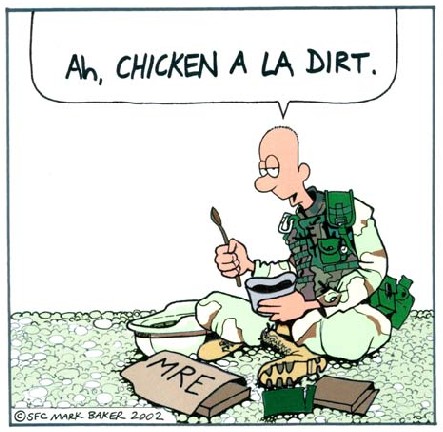
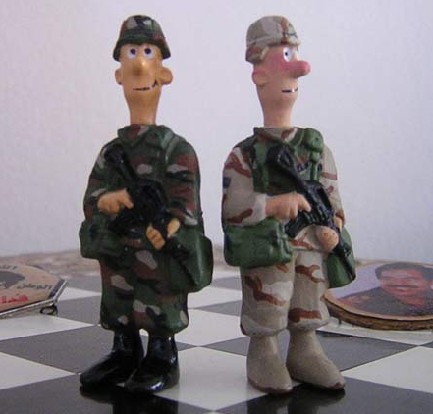 On your desk?
On your desk?
 RETURN TO AES HOME PAGE
RETURN TO AES HOME PAGE